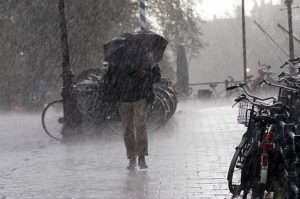Heavy rains in Bengal due to Bay of Bengal depression: In a significant development that has triggered widespread weather alerts across eastern India, heavy rains have lashed Bengal as a deep depression over the Bay of Bengal intensifies, threatening coastal districts and urban regions like Kolkata. The India Meteorological Department (IMD) has issued multiple warnings as the depression system moved closer to the coastline, bringing heavy to very heavy rainfall, strong winds, and the potential for localized flooding.
This weather system, which developed into a deep depression on May 29, 2025, is the first major pre-monsoon weather disturbance of the season in eastern India. It marks a crucial shift in meteorological patterns, indicating early onset of monsoon-like conditions across West Bengal and adjoining states.

Formation and Trajectory of the Bay of Bengal Depression
According to the IMD, the depression formed over the east-central Bay of Bengal due to favorable sea surface temperatures, low wind shear, and high humidity. Over 48 hours, the system intensified, moving northwestwards toward the West Bengal-Bangladesh coastline.
By the early hours of May 29, 2025, the depression strengthened into a deep depression, with a clear cyclonic circulation centered near 21.8°N latitude and 89.0°E longitude. The system lies approximately 120 km south-southeast of Sagar Island (West Bengal) and 150 km south-southwest of Khepupara (Bangladesh).
IMD forecasts suggested that the system would continue moving in a north-northeastward direction, making landfall between Sagar Island and Khepupara, causing intense precipitation and sea disturbances along the Bengal coast.


Impact Across West Bengal Districts
The effects of the depression were felt widely across South Bengal, particularly in districts such as:
-
Kolkata
-
Howrah
-
Hooghly
-
North and South 24 Parganas
-
East and West Midnapore
-
Murshidabad
-
Nadia
-
East Burdwan
Residents in these regions woke up to heavy rainfall, gusty winds, and overcast skies, prompting municipal authorities to initiate emergency response plans.
Kolkata
In the capital city, Kolkata, rainfall began in the early hours of May 29 and continued throughout the day. The Kolkata Municipal Corporation (KMC) deployed emergency drainage teams to manage waterlogging in low-lying areas such as Behala, Topsia, Ultadanga, and Kalighat.
Several roads witnessed accumulated water levels of 6–10 inches, slowing traffic and disrupting office commute.
North and South 24 Parganas
In Basirhat, Canning, and Diamond Harbour, gusty winds uprooted trees and damaged electric poles. Local authorities temporarily shut down ferry services on rivers such as the Ichamati and the Hooghly, citing rough water conditions.

Heavy rains in Bengal due to Bay of Bengal depression: IMD Rainfall and Wind Warnings
As per the IMD’s Orange Alert issued on May 28 and May 29, the following warnings were declared:
-
Heavy to Very Heavy Rainfall: Forecasted for Kolkata, East Midnapore, North 24 Parganas, South 24 Parganas, and Howrah.
-
Windspeeds: Squally winds between 45 to 60 kmph, gusting up to 70 kmph, expected along coastal areas.
-
Sea Conditions: Rough to very rough sea conditions with wave heights reaching up to 3 meters.
The IMD emphasized that fishermen should not venture into the sea till further notice and advised all ports to hoist Signal No. 3 warning flags.
Emergency Response and Evacuation Preparedness
In response to the IMD alerts, the West Bengal Disaster Management Authority (WBDMA) activated its Standard Operating Procedures (SOPs) for cyclonic systems. Some key actions taken include:
-
Evacuation of over 3,000 people from coastal and riverine areas in South 24 Parganas and East Midnapore.
-
Deployment of National Disaster Response Force (NDRF) teams in Digha, Kakdwip, and Namkhana.
-
Activation of storm shelters, with food and water provisions for at least 72 hours.
-
Establishment of emergency helplines in each district for citizen support and rescue coordination.
The Indian Coast Guard and Eastern Railway have also been placed on high alert, with advisories issued to ports, ferry operators, and transportation hubs.
Aviation and Rail Disruptions
The weather system has also affected aviation and railway operations across Bengal:
Airports:
-
At Netaji Subhas Chandra Bose International Airport (NSCBIA) in Kolkata, several flights to Digha, Bagdogra, and Guwahati were delayed due to poor visibility and rain-induced technical constraints.
-
Airlines such as IndiGo, Vistara, and Air India issued travel advisories to passengers for May 29 and 30.
Railways:
-
Eastern and South Eastern Railways temporarily suspended suburban train operations between Howrah and Haldia, Sealdah and Canning, citing waterlogged tracks.
-
Long-distance trains such as the Shalimar Express and Tamralipta Express reported delays ranging from 1 to 3 hours.
Agricultural Impact: Pre-Kharif Concerns
The sudden spell of heavy rain has raised alarms among farmers preparing for the Kharif season.
-
In East Midnapore, Betel leaf cultivators reported damage to saplings due to waterlogging.
-
Paddy field preparation in Nadia and Murshidabad was delayed as fields were inundated prematurely.
-
The Horticulture Department warned of a potential outbreak of fungal diseases if water doesn’t recede quickly.
The West Bengal Agriculture Department has advised farmers to use fungicide sprays, ensure drainage, and report crop damage through the “Bangla Krishi Seva” portal.
Government and Political Reactions
Chief Minister Mamata Banerjee held a high-level review meeting at Nabanna, directing district magistrates and civil defense authorities to remain in “maximum alert mode.” She emphasized zero tolerance for infrastructure failure and urged district administrations to:
-
Monitor embankments
-
Activate relief kitchens
-
Provide uninterrupted power and water supply in shelters
The opposition BJP criticized the Trinamool Congress government, alleging that Kolkata’s drainage preparedness was inadequate. Senior BJP leader Suvendu Adhikari tweeted photos of waterlogged roads in Salt Lake and Alipore, stating that “Kolkata is once again sinking with the first shower.”
Expert Viewpoints
Weather scientists and environmentalists have commented on the increasing intensity of such pre-monsoon systems.
Dr. S.S. Acharya, IMD Kolkata Director:
“This depression was caused by high ocean heat content and minimal vertical wind shear—classic ingredients for cyclonic development. This trend is likely to continue due to climate change.”
Dr. Debanjan Roy, Climate Scientist, Presidency University:
“Bengal’s monsoon calendar is shifting. Urban flooding is no longer a monsoon-only phenomenon. The government must build city-wide climate resilience infrastructure now.”
Future Outlook and Forecast
According to the IMD’s five-day forecast, the depression will gradually weaken over Bangladesh but continue to impact weather in north Bengal and parts of northeast India:
-
May 30–31: Heavy rainfall likely in Jalpaiguri, Darjeeling, Alipurduar, Coochbehar, and Malda.
-
June 1–2: Scattered rainfall with occasional thundershowers in the rest of Bengal.
The monsoon’s official onset over Kerala was also reported on May 29. This system in the Bay of Bengal is expected to accelerate the monsoon’s arrival over Odisha, Jharkhand, and southern West Bengal by the first week of June.
Public Safety and Advisory Guidelines
The West Bengal government and IMD have issued the following safety guidelines:
-
Stay indoors during thunderstorms and lightning.
-
Do not take shelter under trees or signboards.
-
Keep emergency kits ready: torch, candles, drinking water, dry food.
-
Unplug electrical appliances during power surges.
-
Follow official alerts via IMD app, West Bengal Disaster Management mobile portal, and FM radio.
The deep depression over the Bay of Bengal has emerged as a seasonal climate threat for West Bengal, triggering heavy rains, strong winds, and civic disruptions across districts. While the government has activated emergency response mechanisms, the incident underscores the need for long-term urban planning, better drainage systems, climate-aware agricultural practices, and improved cyclone forecasting infrastructure.
As the monsoon inches closer, Bengal must brace for more such climate events and equip its cities and villages with the tools to weather the storm — quite literally.
Useful Links and Resources
Also read: Home | Channel 6 Network – Latest News, Breaking Updates: Politics, Business, Tech & More

